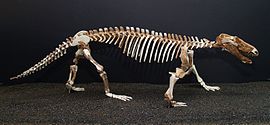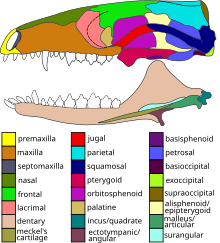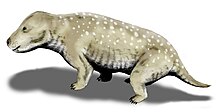| Cynodontia Temporal range: Late Permian-Recent, 260–0 Ma PreꞒ Ꞓ O S D C P T J K Pg N | |
|---|---|

| |
| Examples of cynodonts. 1st row: Dvinia prima, Trirachodon berryi; | |
| Scientific classification | |
| Domain: | Eukaryota |
| Kingdom: | Animalia |
| Phylum: | Chordata |
| Clade: | Synapsida |
| Clade: | Therapsida |
| Clade: | Eutheriodontia |
| Clade: | Cynodontia Owen, 1861 |
| Clades | |
Cynodontia (lit. 'dog-teeth') is a clade of eutheriodont therapsids that first appeared in the Late Permian (approximately 260 mya), and extensively diversified after the Permian–Triassic extinction event. Mammals are cynodonts, as are their extinct ancestors and close relatives (Mammaliaformes), having evolved from advanced probainognathian cynodonts during the Late Triassic.
Non-mammalian cynodonts occupied a variety of ecological niches, both as carnivores and as herbivores. Following the emergence of mammals, most other cynodont lines went extinct, with the last known non-mammaliaform cynodont group, the Tritylodontidae, having its youngest records in the Early Cretaceous.
Description

Early cynodonts have many of the skeletal characteristics of mammals. The teeth were fully differentiated and the braincase bulged at the back of the head. Outside of some crown-group mammals (notably the therians), all cynodonts probably laid eggs. The temporal fenestrae were much larger than those of their ancestors, and the widening of the zygomatic arch in a more mammal-like skull would have allowed for more robust jaw musculature. They also have the secondary palate that other primitive therapsids lacked, except the therocephalians, who were the closest relatives of cynodonts. (However, the secondary palate of cynodonts primarily comprises the maxillae and palatines as in mammals, whereas the secondary palate of the therocephalians primarily comprises the maxillae and the vomer.) The dentary was the largest bone in their lower jaw.

The cynodonts probably had some form of warm-blooded metabolism. This has led to many reconstructions of cynodonts as having fur. Being endothermic they may have needed it for thermoregulation, but fossil evidence of their fur (or lack thereof) has been elusive. Modern mammals have Harderian glands secreting lipids to coat their fur, but the telltale imprint of this structure is only found from the primitive mammal Morganucodon and onwards. Nonetheless, recent studies on Permian synapsid coprolites show that more basal therapsids may have had fur, and at any rate fur was already present in Mammaliaformes such as Castorocauda and Megaconus.

Early cynodonts had numerous small foramina on their snout bones, similar to reptiles. This suggests that they had immobile, non-muscular lips like those of lizards, and lacked muscular cheeks. As a muscular, mobile face is necessary to perform whisking movements and to avoid damage to whiskers, it is unlikely that early cynodonts had whiskers. In prozostrodontian cynodonts, the group that includes mammals, the foramina are replaced by a single large infraorbital foramen, which indicates that the face had become muscular and that whiskers would have been present.
Derived cynodonts developed epipubic bones. These served to strengthen the torso and support abdominal and hindlimb musculature, aiding them in the development of an erect gait, but at the expense of prolonged pregnancy, forcing these animals to give birth to highly altricial young as in modern marsupials and monotremes. Only placentals, and perhaps Megazostrodon and Erythrotherium, would lose these. A specimen of Kayentatherium does indeed demonstrate that at least tritylodontids already had a fundamentally marsupial-like reproductive style, but produced much higher litters at around 38 perinates or possibly eggs.
Cynodonts are the only known synapsid lineage to have produced aerial locomotors, with gliding being known in haramiyidans and various mammal groups, and placental mammals having developed flight.
The largest known non-mammalian cynodont is Scalenodontoides, a traversodontid, which has been estimated to have a maximum skull length of approximately 617 millimetres (24.3 in) based on a fragmentary specimen.
Evolutionary history
See also: Evolution of mammals
The closest relatives of cynodonts are therocephalians, with which they form the clade Eutheriodontia.
The earliest cynodonts are known early Lopingian (early Wuchiapingian) aged sediments of the Tropidostoma Assemblage Zone, in the Karoo Supergroup of South Africa, belonging to the basal family Charassognathidae. Fossils of Permian cynodonts are relatively rare outside of South Africa, with the most widely distributed genus being Procynosuchus, which is known from South Africa, Germany, Tanzania, Zambia, and possibly Russia.
Cynodonts expanded rapidly in diversity after the Permian–Triassic extinction event. Peak disparity in cynodonts occurred from the Induan to the Carnian and in the middle Norian. Post-Early Triassic cynodonts were dominated by members of the advanced clade Eucynodontia, which has two main subdivisions, the predominantly herbivorous Cynognathia and the predominantly carnivorous Probainognathia. During the Early and Middle Triassic, cynodont diversity was dominated by members of Cynognathia, and members of Probainognathia would not become prominent until the Late Triassic (early Norian). Almost all Middle Triassic cynodonts are known from Gondwana, with only one genus (Nanogomphodon) having been found in the Northern Hemisphere. Among the most dominant groups of Middle and Late Triassic cynodonts is the herbivorous Traversodontidae, predominantly in Gondwana, which reached a peak diversity in the Late Triassic. Mammaliaformes originated from probainognathian cynodonts during the Late Triassic. Early Mammaliaformes were small bodied insectivores. Only two groups of non-mammaliaform cynodonts existed beyond the end of the Triassic, both belonging to Probainognathia. The first is the insectivorous Tritheledontidae, which briefly lasted into the Early Jurassic. The second is the herbivorous Tritylodontidae, which first appeared in the latest Triassic, which were abundant and diverse during the Jurassic, predominantly in the Northern Hemisphere, persisted into the Early Cretaceous (Barremian-Aptian) in Asia, at least until around 120 million years ago, as represented by Fossiomanus from China.
During their evolution, the number of cynodont jaw bones reduced. This move towards a single bone for the mandible paved the way for other bones in the jaw, the articular and angular, to migrate to the cranium, where they function as parts of the mammalian hearing system.
Cynodonts also developed a secondary palate in the roof of the mouth. This caused air flow from the nostrils to travel to a position in the back of the mouth instead of directly through it, allowing cynodonts to chew and breathe at the same time. This characteristic is present in all mammals.
Taxonomy
Richard Owen named Cynodontia in 1861, which he assigned to Anomodontia as a family. Robert Broom (1913) reranked Cynodontia as an infraorder, since retained by others, including Colbert and Kitching (1977), Carroll (1988), Gauthier et al. (1989), and Rubidge and Cristian Sidor (2001). Olson (1966) assigned Cynodontia to Theriodontia, Colbert and Kitching (1977) to Theriodontia, and Rubridge and Sidor (2001) to Eutheriodontia. William King Gregory (1910), Broom (1913), Carroll (1988), Gauthier et al. (1989), Hopson and Kitching (2001) and Botha et al. (2007) all considered Cynodontia as belonging to Therapsida. Botha et al. (2007) seems to have followed Owen (1861), but without specifying taxonomic rank.
Phylogeny





Below is a cladogram from Ruta, Botha-Brink, Mitchell and Benton (2013) showing one hypothesis of cynodont relationships:
Distribution
Non-mammalian cynodonts have been found in South America, India, Africa, Antarctica, Asia, Europe and North America.
See also
References
- Ruben, J.A.; Jones, T.D. (2000). "Selective Factors Associated with the Origin of Fur and Feathers". American Zoologist. 40 (4): 585–596. doi:10.1093/icb/40.4.585.
- Bajdek, Piotr (2015). "Microbiota and food residues including possible evidence of pre-mammalian hair in Upper Permian coprolites from Russia". Lethaia. 49 (4): 455–477. doi:10.1111/let.12156.
- Estes, Richard (1961). "Cranial anatomy of the cynodont reptile Thrinaxodon liorhinus". Bulletin of the Museum of Comparative Zoology. 125: 165–180.
- Benoit, J.; Manger, P. R.; Rubidge, B. S. (9 May 2016). "Palaeoneurological clues to the evolution of defining mammalian soft tissue traits". Scientific Reports. 6 (1): 25604. Bibcode:2016NatSR...625604B. doi:10.1038/srep25604. ISSN 2045-2322. PMC 4860582. PMID 27157809.
- Benoit, Julien; Ruf, Irina; Miyamae, Juri A.; Fernandez, Vincent; Rodrigues, Pablo Gusmão; Rubidge, Bruce S. (2020). "The Evolution of the Maxillary Canal in Probainognathia (Cynodontia, Synapsida): Reassessment of the Homology of the Infraorbital Foramen in Mammalian Ancestors". Journal of Mammalian Evolution. 27 (3): 329–348. doi:10.1007/s10914-019-09467-8. eISSN 1573-7055. ISSN 1064-7554. S2CID 254702274.
- Benoit, J.; Manger, P. R.; Rubidge, B. S. (9 May 2016). "Palaeoneurological clues to the evolution of defining mammalian soft tissue traits". Scientific Reports. 6 (1): 25604. Bibcode:2016NatSR...625604B. doi:10.1038/srep25604. ISSN 2045-2322. PMC 4860582. PMID 27157809. S2CID 4318400.
- Michael L. Power, Jay Schulkin. The Evolution of the Human Placenta. pp. 68–.
- Jason A. Lillegraven, Zofia Kielan-Jaworowska, William A. Clemens, Mesozoic Mammals: The First Two-Thirds of Mammalian History, University of California Press, 17 December 1979 – 321
- Hoffman, Eva A.; Rowe, Timothy B. (2018). "Jurassic stem-mammal perinates and the origin of mammalian reproduction and growth". Nature. 561 (7721): 104–108. Bibcode:2018Natur.561..104H. doi:10.1038/s41586-018-0441-3. PMID 30158701. S2CID 205570021.
- Meng, Qing-Jin; Grossnickle, David M.; Di, Liu; Zhang, Yu-Guang; Neander, April I.; Ji, Qiang; Luo, Zhe-Xi (2017). "New gliding mammaliaforms from the Jurassic". Nature. 548 (7667): 291–296. Bibcode:2017Natur.548..291M. doi:10.1038/nature23476. PMID 28792929. S2CID 205259206.
- Basic Biology (2015). "Bats".
- Tolchard, Frederick; Kammerer, Christian F.; Butler, Richard J.; Hendrickx, Christophe; Benoit, Julien; Abdala, Fernando; Choiniere, Jonah N. (26 July 2021). "A new large gomphodont from the Triassic of South Africa and its implications for Gondwanan biostratigraphy". Journal of Vertebrate Paleontology. 41 (2): e1929265. Bibcode:2021JVPal..41E9265T. doi:10.1080/02724634.2021.1929265. ISSN 0272-4634. S2CID 237517965.
- Angielczyk, Kenneth D.; Kammerer, Christian F. (22 October 2018). "Non-Mammalian synapsids: the deep roots of the mammalian family tree". In Zachos, Frank; Asher, Robert (eds.). Mammalian Evolution, Diversity and Systematics. De Gruyter. pp. 117–198. doi:10.1515/9783110341553-005. ISBN 978-3-11-034155-3. S2CID 92370138.
- Huttenlocker, Adam K.; Sidor, Christian A. (1 December 2020). "A Basal Nonmammaliaform Cynodont from the Permian of Zambia and the Origins of Mammalian Endocranial and Postcranial Anatomy". Journal of Vertebrate Paleontology. 40 (5): e1827413. Bibcode:2020JVPal..40E7413H. doi:10.1080/02724634.2020.1827413. ISSN 0272-4634. S2CID 228883951.
- Ruta, Marcello; Botha-Brink, Jennifer; Mitchell, Stephen A.; Benton, Michael James (22 October 2013). "The radiation of cynodonts and the ground plan of mammalian morphological diversity". Proceedings of the Royal Society B: Biological Sciences. 280 (1769): 20131865. doi:10.1098/rspb.2013.1865. ISSN 0962-8452. PMC 3768321. PMID 23986112.
- ^ Ruta, M.; Botha-Brink, J.; Mitchell, S. A.; Benton, M. J. (2013). "The radiation of cynodonts and the ground plan of mammalian morphological diversity". Proceedings of the Royal Society B: Biological Sciences. 280 (1769): 20131865. doi:10.1098/rspb.2013.1865. PMC 3768321. PMID 23986112.
- ^ Abdala, Fernando; Gaetano, Leandro C. (2018), Tanner, Lawrence H. (ed.), "The Late Triassic Record of Cynodonts: Time of Innovations in the Mammalian Lineage", The Late Triassic World, vol. 46, Cham: Springer International Publishing, pp. 407–445, doi:10.1007/978-3-319-68009-5_11, ISBN 978-3-319-68008-8, retrieved 24 May 2021
- Grossnickle, David M.; Smith, Stephanie M.; Wilson, Gregory P. (October 2019). "Untangling the Multiple Ecological Radiations of Early Mammals". Trends in Ecology & Evolution. 34 (10): 936–949. doi:10.1016/j.tree.2019.05.008. PMID 31229335. S2CID 195327500.
- Mao, Fangyuan; Zhang, Chi; Liu, Cunyu; Meng, Jin (7 April 2021). "Fossoriality and evolutionary development in two Cretaceous mammaliamorphs". Nature. 592 (7855): 577–582. Bibcode:2021Natur.592..577M. doi:10.1038/s41586-021-03433-2. eISSN 1476-4687. ISSN 0028-0836. PMID 33828300. S2CID 233183060.
- Classification of R. Owen 1861.
- Classification of B. S. Rubidge and C. A. Sidor 2001
- R. Broom. 1913. A revision of the reptiles of the Karroo. Annals of the South African Museum 7(6):361–366
- S. H. Haughton and A. S. Brink. 1954. A bibliographical list of Reptilia from the Karroo Beds of South Africa. Palaeontologia Africana 2:1–187
- Abdala, Fernando; Ribeiro, Ana Maria (2010). "Distribution and diversity patterns of Triassic cynodonts (Therapsida, Cynodontia) in Gondwana". Palaeogeography, Palaeoclimatology, Palaeoecology. 286 (3–4): 202–217. Bibcode:2010PPP...286..202A. doi:10.1016/j.palaeo.2010.01.011.
- Lucas, Spencer G. (2001). Chinese Fossil Vertebrates. New York City, Chichester, West Sussex: Columbia University Press. p. 133. ISBN 0-231-08482-X. Retrieved 30 November 2019.
- Fraser, Nicholas C.; Sues, Hans-Dieter (1997). In the Shadow of the Dinosaurs: Early Mesozoic Tetrapods. Cambridge University Press.
- Sues, Hans-Dieter; Olsen, Paul E.; Carter, Joseph G. (1999). "A Late Triassic Traversodont Cynodont From the Newark Supergroup of North Carolina" (PDF). Journal of Vertebrate Paleontology. 19 (2): 351–354. Bibcode:1999JVPal..19..351S. doi:10.1080/02724634.1999.10011146.
Further reading
- Hopson, J.A.; Kitching, J.W. (2001). "A probainognathian cynodont from South Africa and the phylogeny of non-mammalian cynodonts". Bull. Mus. Comp. Zool. 156: 5–35.
- Davis, Dwight (1961). "Origin of the Mammalian Feeding Mechanism". Am. Zoologist, 1:229–234.
External links
- Palaeos cynodonts
- Phylogeny of Theriodonts and Cynodonts
- Bennett and Ruben 1986. The Metabolic and Thermoregulatory Status of Therapsids
- BBC cynodonts
| Synapsida | |||||||||||||||||||||||||||||||||||
|---|---|---|---|---|---|---|---|---|---|---|---|---|---|---|---|---|---|---|---|---|---|---|---|---|---|---|---|---|---|---|---|---|---|---|---|
| |||||||||||||||||||||||||||||||||||
| |||||||||||||||||||||||||||||||||||
| |||||||||||||||||||||||||||||||||||
| |||||||||||||||||||||||||||||||||||
| |||||||||||||||||||||||||||||||||||
| Cynodontia | |||||||||||||||||||||||||||||||||||
|---|---|---|---|---|---|---|---|---|---|---|---|---|---|---|---|---|---|---|---|---|---|---|---|---|---|---|---|---|---|---|---|---|---|---|---|
| |||||||||||||||||||||||||||||||||||
| |||||||||||||||||||||||||||||||||||
| |||||||||||||||||||||||||||||||||||
| |||||||||||||||||||||||||||||||||||
| |||||||||||||||||||||||||||||||||||
| Taxon identifiers | |
|---|---|
| Cynodontia | |











